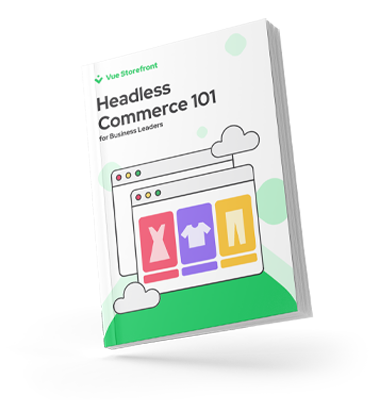10 min
August 11, 2025
Headless Commerce and SEO: How to Make Them Work Together
Headless commerce is on the rise; there's no doubt about it. Enterprises, large brands, and international e-commerce companies are seriously evaluating the potential of abandoning their monolithic systems in favor of composite ones, or they have already made the switch.
But changing an entire architecture is a significant undertaking. You and your team might be asking questions like:
"Will this even pay off?"
"Will it help or hurt the SEO we've so consistently built over the years?"
"Will we maintain our organic visibility after the change?"
Well, for most eCommerce businesses, SEO is usually one of the most crucial aspects to consider before deciding to disrupt their eCommerce stack. We've heard this many times from our clients, and no wonder!
Organic search is one of the critical channels for acquiring traffic in eCommerce. Let's find out if headless commerce can help your SEO.
Listen to the audio version of this article.
Is there any difference between traditional and headless approaches for SEO?
First, let's briefly explain how the headless approach differs from the traditional eCommerce model to understand its potential implications for SEO.
The definition of headless commerce states that by adopting a headless approach, you decouple the frontend and backend layers of the entire eCommerce system. These two, and sometimes additional, external elements such as search engines or payment systems, communicate with each other through an orchestration layer, AKA API.
 In contrast, monoliths have all functionalities integrated into a single software application. The business logic, as well as the presentation layer, are combined into one software package. Sometimes third-party plugins or extensions are available, but they are merely additions to having a single, coupled system and are installed directly onto it.
In contrast, monoliths have all functionalities integrated into a single software application. The business logic, as well as the presentation layer, are combined into one software package. Sometimes third-party plugins or extensions are available, but they are merely additions to having a single, coupled system and are installed directly onto it.
 One might get the impression that headless commerce is much more complicated than a simple all-in-one solution, or that such an approach is overkill.
One might get the impression that headless commerce is much more complicated than a simple all-in-one solution, or that such an approach is overkill.
Well, at first glance, it might seem like unnecessary hassle, but the more you familiarize yourself with the concept of headless architecture, the more you'll realize that it actually simplifies many things, while simultaneously opening up a world of possibilities.
The fact is, the larger the scale and aspirations of your business, the more benefits you'll see from headless commerce. And this also reflects on SEO.
Headless commerce won't revolutionize what your SEO strategy will look like, but it can significantly accelerate its implementation, especially on the technical side.
Let's get down to specifics on how headless architecture improves the way your site – and business – better serves users and becomes much easier to enhance.
Adaptability is Built into the DNA of Headless Commerce
The ability to easily change various functionalities, information architecture, HTML, or microdata tagging is something every eCommerce SEO professional desires.
eCommerce websites must evolve to keep up with constantly changing technological standards, satisfy Google's algorithm, and maintain or achieve a competitive advantage.

Do you know that feeling when you're dealing with a SaaS or a self-contained legacy platform that won't let you implement a carefully prepared set of SEO tactics due to its technical limitations? I'm sure you do. Consider the following scenarios:
You've noticed an opportunity for significant visibility growth by creating a more advanced site structure. To achieve this, you need to create new URLs based on faceted navigation, but instead, you're forced to accept less SEO-friendly URL parameters and forget about impressive organic growth.
Perhaps you've noticed that Google provides more rich snippet opportunities almost every month. Some of them offer fantastic ways for your pages to be presented in SERPs more enticingly. However, if your monolithic CMS provider isn't quick to react and simply doesn't support new microdata types, then you're stuck with what you have now. But guess who will benefit from the new opportunities? Your competition.
Your legacy system was created in a time when everyone was just getting excited about the possibilities of JavaScript, so most of your eCommerce content is generated using client-side rendering. As someone who knows how search engines work, you know that Google might simply ignore your product descriptions and images, no matter how well optimized they are.
Google will spend more crawl budget resources to fully render your content in such a case. If your site has millions of URLs, there's a good chance that some of your new products won't be indexed for weeks or even months. Not to mention other search engines that don't even have the capability to render JS.

These are just three examples of common problems that SEO and eCommerce specialists may encounter when optimizing their stores. Headless commerce will make them easier to fix and other SEO recommendations easier to implement.
Implementing custom URL structures alongside complex facet-based navigation or new schema markups is possible. Similarly, headless frontends, such as Vue Storefront, are evolving towards ticking all the boxes related to technical optimization, which will give you an advantage over the competition. Read on to learn more about the technical aspects.
Most top headless CMSs and headless commerce platforms allow for full customization, enabling you to add new structures with complex dependencies to your website or tag content with microdata.
Another amazing asset of headless commerce is that you can easily decouple and replace your eCommerce solutions, such as your CMS, with another API-first solution.
Okay, but what about the eCommerce Storefront in a headless commerce approach – its code, content discoverability, and speed?

Better SEO right from the start
The part of your eCommerce site that serves as both a gateway for customers and for Google's algorithm is its frontend.
Considering monolithic platforms, the presentation layer is coupled with the backend in a single system, which can sometimes be a less-than-perfect combination.
So, what do alternative headless frontend solutions, like Vue Storefront, offer to accelerate SEO that monoliths don't always have?

Server-Side Rendering (SSR)
If you're not familiar with SSR and why it matters, let me introduce you. From the most basic perspective, there are two primary ways a visible part of a page can be rendered:
Client-side rendering (CSR) means that for the frontend to be correctly displayed in the user's browser, the browser itself will need to do the work of executing and interpreting JavaScript code. Server-side rendering (SSR) means that this process is handled by the server, and ready-to-display HTML code is served directly to the browser with little to no need for JavaScript code processing.
SSR brings immense SEO value, especially for large eCommerce sites. Since developing and rendering JavaScript into simple HTML consumes browser computing resources, it's very similar for search engines. They also need to render JS code to index content.
It's worth mentioning that currently, Google is the only widely used search engine that offers this option. Neither Bing, Yandex, nor Baidu will even be able to "see" your content if it requires JavaScript rendering.
The rendering process requires a lot of resources, so Google doesn't always fully render JavaScript-based pages. It might do so in a second index pass or completely abandon such a URL and keep it in a supplementary index.
So, having eCommerce content served to both users and search engines in clean HTML (with CSS styling, of course) can be treated as a risk-mitigating aspect. It's simply better to be sure that Google will be able to crawl all your page content.
Let's say you're adding new products with detailed descriptions and original graphics. You should be sure that they will be processed by the algorithm as quickly as possible, right?
This is something Vue Storefront does out-of-the-box thanks to the cutting-edge capabilities of JavaScript frameworks (Vue.js and Nuxt). Server-side rendering is an aspect of our product that our development team has taken care of, so you don't have to.

Speed
Another crucial SEO aspect for eCommerce Storefronts is that they must perform quickly. It's not difficult to find numerous statistics and reports across the web proving that high performance of online stores directly correlates with a higher conversion rate and better SEO results.
As you probably already know, the battle for fast websites is an ongoing process, and Vue Storefront takes it very seriously. We constantly iterate our product to make our clients' stores faster than the competition.
And what exactly do we offer?
Lazy load - The idea of lazy loading images is to delay sending requests for images until the image appears in the viewport. So essentially, if you have an image in the footer, the request for it will only be made when the user scrolls down to it.
Compression - Ah, images... One of the biggest bottlenecks when it comes to speed optimization. Image size can be a dealbreaker, and optimization usually involves some level of compromise.
Generally, the more you compress, the worse the quality, but fortunately, there are ways to handle this. The latest compression algorithms are much more effective than they used to be. At Vue Storefront, we use Brotli compression, which will significantly reduce the overall file size of your application.
CDN - If your eCommerce is international or you operate in large countries like the USA, having a Content Delivery Network will speed up the process of serving content requested by users in distant locations. Vue Storefront has an optional Google CDN integration for those who want to provide an excellent user experience at all touchpoints.

Semantic code
Google loves clean and understandable code with Schema.org markups, which we've already discussed, but we haven't mentioned semantic tagging, available since HTML5.
Semantic HTML is more descriptive compared to previous HTML versions. It provides additional information for search engines. For example, there are separate <header>, <footer>, <article>, <nav> tags, which are quite clear about what they represent.
This is helpful for Google to understand the page and for visually impaired people who use assistive technologies like screen readers.
Suppose you need an eCommerce UI library that will be helpful for a wider audience and easily understandable by the algorithm. In that case, Vue Storefront has a backend with our Storefront UI that has this implemented out-of-the-box.
Re-platforming with Headless Commerce Will Save Your SEO
Another hot topic for SEO specialists is re-platforming, which essentially means migrations. So how can headless commerce help with this?
If you've worked in the eCommerce industry long enough, chances are you've encountered the need to re-platform and migrate to different eCommerce platforms at least once in your career.
And if that's true, then you know that one of the biggest fears that comes with anyone responsible for this process is the loss of organic visibility, which was the result of years of SEO work.
The visibility graph below shows one of these unfortunate migrations:

With headless commerce, you can avoid such a scenario because you can adopt a more agile, iterative approach.
Thanks to headless, you can easily perform migrations in stages. For example, you can simply start by replacing your old CSR-based frontend and substitute it with a headless solution like Vue Storefront, while keeping your business logic intact.
If you're working on Magento or Shopify, you can easily replace their coupled frontend solution and simply plug in Vue Storefront via API without losing all your content and business logic in the backend.
Only after you ensure that this part of the process goes smoothly can you proceed with re-platforming, if you see the need for it.
The beauty of headless commerce is its composability and the flexible approach it offers to changes.
Final musings
SEO strategies will be the same whether you use headless commerce or a monolithic, centralized system. However, what will differ with headless commerce is the ability to execute those strategies without unnecessary technical roadblocks.
You can achieve this with the best solutions headless commerce offers.
Headless frontend? No problem. Vue Storefront will allow you to build a storefront site in a way that has all the technical requirements in place. Fast loading, full rendering, and clean, semantic code – such a technical foundation will allow your marketing team to focus on business aspects instead of struggling with old systems and their technical limitations.
Headless CMS? Voila! You can quickly implement new structures, new tagging, and better automated associations because they are made with customization as a priority.
Headless eCommerce platforms? Sure, you can keep your business logic separate. Weak built-in frontends or hard-to-code technical optimizations won't prevent you from optimizing what matters to Google.
I hope these arguments are convincing for you, and if you have any questions about our frontend platform, go straight to the contact form or request a demo.
Original author: JAKUB PEPLIŃSKI




